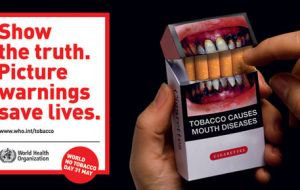MercoPress. South Atlantic News Agency
WHO: Tobacco packages must use pictorial warnings

For another year in a row the World Health Organization (WHO) declares May 31 for a world no-smoking day. It draws global attention to the widespread prevalence of tobacco use and to its negative health effects. Every year the WHO joins all the people worldwide around a topic towards reducing tobacco consumption. This year’s subject is: health warning messages on the packaging of cigarettes and other tobacco products.
Health warnings on tobacco packaging that combine text and pictures are one of the most cost-effective ways to increase public awareness of the serious health risks of tobacco use and reduce consumption.
Today, World Health Organization urged governments to require that all tobacco packages include pictorial warnings to show the sickness and suffering caused by tobacco use.
Studies reveal that, even among people who know tobacco is harmful; few understand its specific health risks. Health warnings on tobacco packaging in most countries do not provide information on these risks.
“Despite the fact that more countries are using pictorial warnings, 9 out of 10 people in the world do not have access to pictorial warnings on tobacco packages. This represents a tragic under use of a simple, cost-effective strategy that can vastly reduce tobacco use and save lives,” says Dr Marc Danzon, WHO Regional Director for Europe.
The leading preventable cause of death, tobacco kills more than 5 million people every year. About 1.6 million of these deaths occur in the WHO European Region. Tobacco is the only legal consumer product that kills when used exactly as intended by the manufacturer.
Effective health warnings, especially those that include pictures, have been proved to motivate users to quit and to reduce the appeal of tobacco to people who are not yet addicted. Yet only 10% of the world’s population lives in countries that require pictorial warnings on tobacco packaging.
Only 5% of the global population lives in countries with comprehensive bans on tobacco advertising, promotion and sponsorship. About half of the children in the world live in countries that do not ban free distribution of tobacco products.
More than 40% of the world’s population lives in countries that do not prevent the use of misleading terms such as light and low-tar, even though conclusive scientific evidence shows that such products do not reduce health risks.
Tobacco companies spend tens of millions of dollars every year turning new users into addicts and keeping current users from quitting. Through advertising and promotional campaigns, including the use of carefully crafted package designs, the tobacco industry continues to divert attention from the deadly effects of its products.
More than 160 countries have ratified the WHO Framework Convention on Tobacco Control, making it one of the most widely embraced treaties in United Nations history. The Convention commits its Parties to ensuring that tobacco products “carry health warnings describing the harmful effects of tobacco use”. Its best-practice guidelines stipulate that warnings should be large and clear, appear on the front and back of tobacco packaging and describe specific illnesses caused by tobacco.




Top Comments
Disclaimer & comment rulesCommenting for this story is now closed.
If you have a Facebook account, become a fan and comment on our Facebook Page!